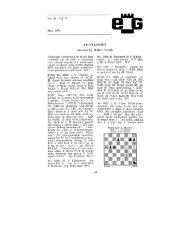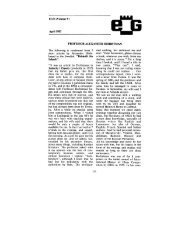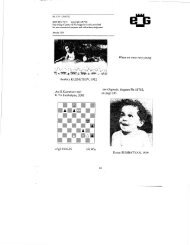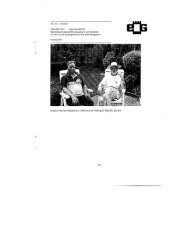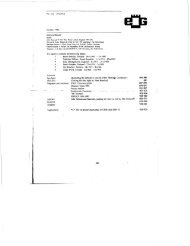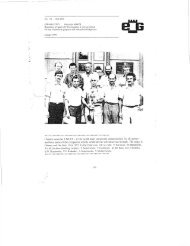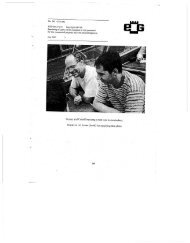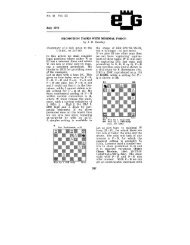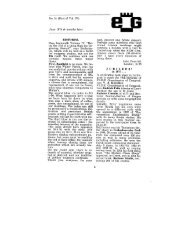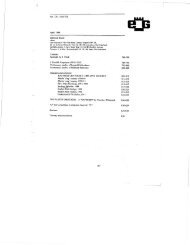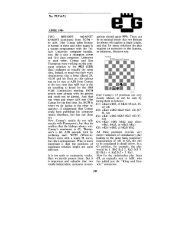LADISLAV PROKES THE PLAYER'S COMPOSER - Gady Costeff
LADISLAV PROKES THE PLAYER'S COMPOSER - Gady Costeff
LADISLAV PROKES THE PLAYER'S COMPOSER - Gady Costeff
You also want an ePaper? Increase the reach of your titles
YUMPU automatically turns print PDFs into web optimized ePapers that Google loves.
No. 7<br />
JANUARY 1967<br />
<strong>LADISLAV</strong> <strong>PROKES</strong><br />
<strong>THE</strong> <strong>PLAYER'S</strong> <strong>COMPOSER</strong><br />
The following talk was given by A. J. Roycroft to The Chess Endgame<br />
Study Circle on Friday, 7.x.66 at St. Bride's Institute, London E C 4.<br />
If there is a single composer whose work is likely to make studies<br />
really popular, that composer is Prokes. His positions have few pieces,<br />
and the pieces are naturally placed. The solution is short. Profound<br />
and lengthy analysis is not needed. The position leads the solver to<br />
think that a direct game-approach is sufficient, so that when this<br />
proves not to be so the solver will have learned something, and he will<br />
have been pleasantly surprised. This means that what he learns he is<br />
likely to retain, and from a typical Prokes study he can learn not only<br />
A. L. Prokes B. I*. Prokes<br />
Svobodne Slovo, l.xi.46<br />
Prace, 27.vli.47<br />
2 2<br />
Draw<br />
1. KfT/i a5 2. f4/ji s4/iii 3. £5<br />
n3 4. f6 a2 5. Kg8=/iv.<br />
i) 1. f4? K£4 2. Kf7 Kf5 wins.<br />
but not 2. . . a5? 3. Ke6 graining<br />
a tempo by threatening<br />
both f4 and Kd5.<br />
ii) 2. Ke6? loses a tempo on<br />
(i) as bK has not moved. 2.<br />
. . a4 3. £4 as 4. fo a2 5. f6<br />
alQ 6. f7 Qa3 wins.<br />
iii > 2. . . Kg4 3. Ke6 is the<br />
same as the second hne in<br />
(i). iv) 5. Ke7? alQ 6. 17<br />
Qc5f 7. KfS Kg5(h5) wins.<br />
The most puzzling study of<br />
the 26. wK moves to f7,<br />
blocking the path of IP. and<br />
then finally returns to g8.<br />
This apparent waste of time<br />
is the only way to draw.<br />
Why? By analogy with the<br />
famous Reti study. wK<br />
should go to e6. yet in the<br />
main line it does not.<br />
1. Kb7 a5 2. Kc6/i a4 3. Kd5<br />
a3/ii 4. Ke4 Kb2 5. Kd3<br />
Kxa2 6. Kc2=. i) 2. Kb6? a4<br />
3. Kc5 a3 and 4. . . Kb2 wins,<br />
ii) 3. . . Kb2 4. Kc4(d4) Kxa2<br />
5. Kc3=, or 3. .. Kd3 4. a3<br />
or 4. Kc5 or 4. Ke5.<br />
157
the tactical trick or tricks that are the composer's idea but also the<br />
simple ground rules of theory that dictate the choice of moves. Lastly,<br />
Prokes composed over 1,000 studies (no one seems to know the exact<br />
total) and many hundreds of them satisfy these requirements. As his<br />
main work, Kniha Sachovych Studii, is very difficult to obtain, perhaps<br />
this small selection of 26 studies from it will be found useful,<br />
both to the beginner in the field of studies (for the reasons already<br />
mentioned), and also to the specialist who may like to acquire a feeling<br />
for Prokes* composing style and composing skill.<br />
In each of the positions I shall suggest something that a player can<br />
learn. There are, of course, many things that can be learned from a<br />
study, but I hope to suggest the less obvious lessons. Many others will<br />
occur to you, and indeed it might be a useful exercise to list all that<br />
could possibly be learned from a given study. If one did this conscientiously<br />
I think one would realise what a great deal of acquired<br />
chess knowledge is necessary for the appreciation of studies. But that<br />
is for another time, and perhaps another speaker. Let us take each<br />
study in turn, go through the solution, and then suggest what can be<br />
learned.<br />
A: Timing. If there are 2 moves to be made (here, for instance 1. Kf7<br />
and 1. f4), see if there is not a reason for choosing one rather than the<br />
other to be the first. The specialist may note that this study goes<br />
deeper than the 1922 Reti, for that idea occurs only in note (iii).<br />
Prckes has included also the draw with fP on the 7th rank against Q.<br />
B: A move that leaves a choice for the following move is superior to<br />
one that does not. 1. Kb7 rather than 1. Ka7, and 2. Kc6 rather than<br />
2. Kb6, etc.<br />
C: Play on, something might turn up!<br />
D: When a P is being pursued by a piece, look not only at the simple<br />
advance of the P but also at quieter moves that restrict the scope of<br />
the piece.<br />
E: If your opponent is ahead in material but restricted in movement,<br />
what you should be thinking about is how he will try to increase his<br />
mobility. You must find good moves for him, so that you can find<br />
better ones for yourself.<br />
F: With a defending K near a corner you should smell stalemate from<br />
a long way off.<br />
G: A better move (Id5f) may often be suggested by analysing an<br />
obvious one (Ia7).<br />
H: Do not be afraid to sacrifice P's, especially when you have to!<br />
I: If your opponent surprises you with a good move (1. .. Kh8), perhaps<br />
it opens new possibilities for you too.<br />
J: Sit on your hands, as Tarrasch said. 1. g7? d6f 2- Rg8 wins, for Bl.<br />
K: Analyse, then look for landmarks (hP, hP.), then analyse again.<br />
L: Zugzwang (2. Kd4, then 3. Kd5, not 2. Kd5) is a frequent weapon<br />
in S-endings, as S's cannot lose or gain single moves.<br />
M: Just because one move is unlikely (1. d6), this does not mean that<br />
there are not more moves that are equally unlikely (3. Kb5 and 4. Ka6).<br />
N: When nothing else works, try a bit of imagination!<br />
O: Ask yourself what the effects are of your opponent's checks, now<br />
and on his following move.<br />
P: A P on the 7th is worth a sacrifice or 2, not excepting the sacrifice<br />
of a P on the 5th or 6th.<br />
Q: Are you quite, quite sure there is not something more?<br />
R: Who said that fantastic things could not happen in natural positions?<br />
Nobody.<br />
158
C. L. Prokes<br />
Obranu Lidu, 3.xii.50<br />
D. L. Prokes<br />
Rude Pravo. 13.x.45<br />
Draw<br />
1. Kf7 Bf8 2. Kxf8 Kxg6 3.<br />
Ke7 Kio 4. Kd6 Ke4 5. Kc5<br />
Kd3 6. Kb4/i Kc2 7. Kxa3<br />
Kxc3 stalemate, i) 6. Kxb5?<br />
Kxc3 wins.<br />
E. L. Prokes<br />
Prace, 24.iv.47<br />
3<br />
Win . 3<br />
1. b6 Sc4 2. a6/i Sxb6 3.<br />
Kd8/ii Kf6 4. Kc7/iii Sa8f/iv<br />
5. Kb7 Ke7 6. Kxa8 wins.<br />
i) 2. b7? Sxa5=. ii) 3. a7?<br />
Sc8|=, but also 3. Kd6? Sc8t<br />
is a standard draw, part of<br />
the armoury of all players,<br />
and therefore very useful<br />
if new to them, 5. Kc7 Sa7<br />
6. Kb7 Sb5 7. Kb6 Sd6 ready<br />
to go to c8 or b5.=. iii) 4.<br />
a7? Ke6 5. Kc7 Sa8f 6. Kb7<br />
Kd7=. iv) 4. .. Sd5f 5. Kb7<br />
wins.<br />
1. Ke6/i Bb8 2. d3/ii Bc7 3.<br />
d4 Bb8 4. Kf6 Ba7(c7) 5. Ke6<br />
Bb8=/iii. i) Why not 1. d4?,<br />
as 1. .. Kd7 is met by 2. K£7.<br />
and l. . . d5 by 2. KeG. Answer;<br />
1. ..Ba5 2.Ke6Bb4 3-Kf6<br />
Bel 4. Ke6 Bg3 5. Kf6 Bh4f<br />
and 6. . . Bxe7 wins, ii) 2.<br />
d4? Bc7 3. d5 Bb8 4. Kf6 Ba7<br />
5. Ke6 Bc5 wins as in (i). as<br />
does 3. Kf6 Ba5 4. Ke6 Bb4.<br />
iii) Only a draw, because<br />
wPd4 prevents . . Bc5, so that<br />
repetition of movrs is forced.<br />
There is a lesson here<br />
in timing (Ke6 when bBc7)<br />
and in space, for on b8 bB<br />
cannot move to any diagonal<br />
except a7-gl, when wPd4<br />
draws, while on c7, if not<br />
tied to bPd6, it can play to<br />
£5 and win.<br />
F. L. Prokes<br />
Rudy Sever, 28.vii.45<br />
3<br />
h6 Bxc4 2. b3f/i Kxb3 3.<br />
h7 Bd3f 4. Kal Bxh7 stalemate,<br />
i) 2. h7? Bd3f wins<br />
because now, when W plays<br />
b3f Bl need not capture.<br />
S: Who's afraid of the Big Black Queen? Certainly not little white<br />
pawns on the 7th rank.<br />
T: A little bit of (Prokes (4. Bhl) proves the study is sound, in the most<br />
159
ilHir.litful way. ilIorkndinK a I 1 in boltor Hum controlling its next<br />
squaiv, it the blockade is j^oin^ to be lifted anyway, because then the<br />
enemy will be left blockading his own P, and perhaps you can use the<br />
tempo (5. Kf4 and 6. K&3).<br />
U: It is so easy not to be careful (the right choice of square for wK<br />
on move 2).<br />
G. L. Prokes<br />
Rude Pravo. ll.vii.48<br />
4<br />
H. L. Prokes<br />
Sachove Studie (1941)<br />
2<br />
Draw 4<br />
1. d5f/i Kxd5 2. a7/ii Ba4f<br />
3. Kd8 Bc6 4. Kc7 Ba8 5. Kb3<br />
BcG 6. Kc7=. i) 1. a7? Bf3<br />
2. 4c Bc6f and 3. . . Kd5<br />
wins, ii) 2. Kd7? Bf3 wins.<br />
I. L. Prokes<br />
Tydschrift KNSB, 1948<br />
2 Hon. Men.<br />
2<br />
Draw<br />
1. Kf4/i Kg7 2. a8Q<br />
Ke5 Kf7 4. Kd6 Ke8 5. Kc6/U<br />
Rc8 6. Kd6 Ra8 7. Kc6=.<br />
i) So that wPc7 can be protected<br />
in 2 wK moves. 1.<br />
a8Q? simply loses both wP's<br />
to bR. ii) This threatens<br />
Kb7.<br />
J. I* Prokes<br />
1st Pr, Loums Ty for Twin<br />
Studies 1942<br />
3<br />
Win 4<br />
1. KfG/i Kh8 2. g6/ii Rd6f 3.<br />
Ke7 Rf6 4. KfS/iii RxgG 5.<br />
K>7/iv Rg7 6. KfG/v Rg6f 7.<br />
Kf5 Kg7 8. f8Qf KxfS 9. Kxg6<br />
wins.<br />
i) Threat 2. gGf Kh6 3. g5f.<br />
ii) 2. Ke7? Kg7= . iii) 4.<br />
KxfG? stalemate. 4. g5? Rf5<br />
5. Kf8 Rxg5=. iv) Now<br />
there is no stalemate, so bR<br />
cannot return to f6. 4. Ke8?<br />
Rxg4 5. f8Qf Rg8=. v) 6.<br />
go? Kh7 7. Ke6/vi Rg6f 8.<br />
Kf5 Rxg5f 9. Kxg5 Kg7=.<br />
vi) 7. Kf6 allows the dual<br />
continuation of (v) or 7.<br />
. . Rx«5 8. f8Q Rf5f 9. Kxf5<br />
stalemate.<br />
1. e7f Kxe7 2. d6f Ke8 3. g7<br />
Rg8/i 4. Kf6 R£8f/ii 5. Kg5<br />
Rg8 6. Kg6 Rf3 7. gf(Q)f<br />
Kxi8 8. Kf6 wins,<br />
i) 3. . . Rf5f 4. Kxf5 Kf7 5.<br />
g8Qf Kxg8 6. Kg6 Kf8 7. Kf6<br />
becomes the main line at<br />
move 8, and the same happens<br />
after 3. .. Kf7 4. gfQf<br />
Kxf8 5. Kf6. ii) 4. . . Kd8 5.<br />
Kf7 Re8 6. g8Q Rxg8 7. Kxg8<br />
Kc8 8. Kf7(f8) Kb7 9. Ke8<br />
Kc6 10. Ke7 wins.<br />
160
K. L. Prokes<br />
1st Pr. Louma Ty for Twin<br />
Studies 1942<br />
3<br />
L. L. Prokes<br />
1-2 Pr. Sachove Studie 1941<br />
2<br />
Draw 4<br />
1. f7f Kxf7 2. e6f Ke8/i 3. h7<br />
Rh8/ii 4. Kg6 Kd8/iii 5. Kg7<br />
Ke8 6. Kxh8 Kf8 stalemate,<br />
i) 2. . . Kf8? 3. h7 Rh8 4. Kg6<br />
Rg8f as in the twin study,<br />
or 4. . . Ke8 5. Kg7 wins,<br />
ii) 3. ..Rf8f? 4. Kg6 wins,<br />
iii) 4. . . Rf8? 5. Kh6 wins.<br />
M. L. Prokes<br />
Hon Men, Enroque 1948<br />
Win 4<br />
1. b7 Sd6f 2. Kd4/i Sxb7 3.<br />
Kd5 Kg7/ii 4. Sd8 Sxd8 5. e7<br />
wins, i) 2. KdS? Sxb7=.<br />
ii) 3. . .Sc5 4. e7 Sa6/iii 5.<br />
Kd6 Kf7 6. Sd8f Ke8 7. Se6<br />
Kil 8. Sg7 Sc7 9. Kd7 Kf6<br />
10. Se8f wins, iii) 4. . . Se6<br />
5. Kd6 Sg7 6. Kd7 Kf5 7.<br />
Sd4f Ke4 8. Se6 Sh5 9. KdP<br />
Sf6 10-11. Sd7 or Sh7.<br />
N. L. Prokes<br />
Hon Men, Pracc 1948-49<br />
4<br />
Win<br />
1. d6 cd 2. b6 Kxa8/i 3.<br />
Kb5/ii Bb8 4. Ka6/iii Ba7 5.<br />
ba or 5. c4 win. i) 2. . . Bb8<br />
3. Kb5 d5 4. Sc7 wins easily,<br />
ii) 3. ba? Kxa7=, or 3. Ka6?<br />
d5 4. ba d4=. The W move<br />
3. Kb5 threatens ba, Kxa7;<br />
Kc€. iii) The Bl defence to<br />
the W threat now allows<br />
this, threatening mate. Familiarity<br />
with K and P v K<br />
underlies this study, and indeed<br />
makes it comprehensible.<br />
Win 4<br />
1. b5f/ Kc7/ii 2. Sd6 Kxd6 3.<br />
Kb7 Bc7/iii 4. Kc8 captures<br />
bB next move and wins,<br />
i) 1. ba? ba 2. Sxa5f Kc5=.<br />
I. Sd8f? Kd7=. ii) bPb6 must<br />
be protected, iii) 3. .. Ba7<br />
4. Kxa7 Kc7 5. Ka6. 3. . . Kc5<br />
4. Kxb8 Kb4 5. Kc7 (b7, a7)<br />
Kxa4 6. Kxb€ Kb4 7. Kc€ a4<br />
8. b6 a3 9. b7 a2 10. bSQf Kc3<br />
II. Qe5| (h8f) Kc2 12. Qal<br />
wins.<br />
V: Consecutive moves by the same piece are easily overlooked when<br />
there seem to be good alternatives.<br />
W: When one man is tied to defend another, look out for the judo<br />
trick of counter-attacking (note ii) to evade the bind.<br />
X: A tempo (2. Se7 with check) can create a position otherwise impossible.<br />
161
Y: Don't think you know It nil (that 2Il f :i nrvrr wiivaKniimt IH!).<br />
Z: "2 united passed T\s on the lith win against a U'\ says theory (see<br />
position K). The perception of the deception ol this exception needs<br />
reception, from the inception.<br />
o.<br />
?. 7.xi.3G<br />
rokes<br />
P. L. Prokes<br />
3 Pr, Prevorovsky Memorial<br />
Ty. 1044<br />
4<br />
Win<br />
1. f6/i gf 2. S£8 Rx£8/ii 3. e7<br />
wins, i) 1. Sf8? Rxf8 2. e7<br />
Rxf5t. which explains W's<br />
move 1. 1. Sg5? Kd6 2. S£7t<br />
Ke7 3. d8Qt Rxd8 4. Sxd8<br />
Kxd8 5. K- Ke7 6. K- g6=.<br />
Draw<br />
1. Sa3/i Rxa3 2. b6/ii ab 3.<br />
Kd7/iii Rf3 4. Ke7/iv Re3t<br />
5. Kd7/v Rd3t 6. Ke7/vi=.<br />
i) With threat 2. Kb7. ii) 2.<br />
Kb7? Rb3. iii) 3. £7? Rf3<br />
and . .Rf8. iv) 4. Ke8? bR<br />
reaches h-file in 2 moves<br />
and wins, v) 5. Kf7? Rc3<br />
wins, vi) 6. Kc7? Rf3 wins.<br />
L. Prokes<br />
?. 8.xi.43<br />
R. L* Prokes<br />
1st Pr, Louma Ty, 1941<br />
2<br />
Win 4<br />
1. h7 Sh6/l 2. Kxh6 Rxa6f 3.<br />
Sf6 Ra8/ii 4. Sg8 Ra3 5. Kg5<br />
Rg3t 6. Kh4 Rgl 7. Sh6 Rhlf<br />
8. Kg5 Rglf 9. Kf6/iii Rflt<br />
10. Ke7 wins by escaping the<br />
checks on the a-file. i) 1.<br />
. . Sd6 2. Kg6 wins, ii) 3.<br />
. . Rxf6f 4. Kg7 wins. iii)<br />
The author's solution stops<br />
at 8. Kg5, and indeed there<br />
is a dual way of winning,<br />
by marching to the 2nd<br />
rank, as . . Rf8, for example,<br />
ia simply met by Sg8.<br />
Win 4<br />
1. d7 Rdl/i 2. Bd5 Rxd5 3. e6<br />
wins, i) 1. . . Ralf 2. Ba2/ii<br />
Rxa2t 3. Kb3 wins. Or 1.<br />
. . Rh8 2. Bg8/iii Rxg8 3. e6<br />
wins, ii) 2. Kb3? Ra8 3. Bd5<br />
Rb8t=. iii) 2. Bf7? Kxe5 3.<br />
Be8 Rh4t and 4. . . Rd4=.<br />
Only 3 nioves in all main<br />
variations until a book win<br />
is reached, but nevertheless<br />
beyond question a worthy<br />
prize-winner. A 3-fold sacrifice<br />
of wB, each time on a<br />
different square.<br />
162
8. JL. Prokcs<br />
Sachovo Studio, 1941<br />
3<br />
T.<br />
L. Prokcs<br />
?, lv.49<br />
Draw<br />
1. Jb7/i Qb3 2. BbG/U jcb 3. c7<br />
Qxc7 4. b8Q Qxb8 stalemate.<br />
j) Threatening tfre quiet 2.<br />
Ka7. 1. JCb7? ph 2. Sxb$ (2.<br />
£7 Qxc7t 3. Kxc7 te> 2.<br />
. . 4505 followed fry<br />
wins, m With aixothex .<br />
ttweai, 3. Pa7. 2. SW?<br />
3-<br />
w|n<br />
U. L. Prokcs<br />
Sachove Studie. 1941<br />
3 V. L. Prokes<br />
Prace, 9J.47<br />
3<br />
Win 3<br />
1. Bb6 Kxb6 2. Kc4/i 12 3.<br />
Sd5f K- 4. Se3 wins, i) This<br />
square must be -chosen to<br />
prevent bK reaching b4 after<br />
wS inanoeuvre. At the end,<br />
W wins simply -by tempoing<br />
with wS as necessary -to ee-<br />
-oure the -Queening of bP.<br />
Win 4<br />
1. f6 Kxc2 2. Bh5/i .e5 3. Bg4<br />
e4 4. Bf5 wins, a
w.<br />
L,. Prokes<br />
->. ll.xi.43<br />
X. L. Prokes<br />
Schwelzerischer Arbeiterschach<br />
iii.50<br />
4<br />
Win 4<br />
1. Ka4 Bcl2/i 2. Se4 Bxa5 3.<br />
Sc5t Kb6 4. Bgl/ii wins. 1)<br />
Relying on the draw by<br />
"wrong B" to threaten 2.<br />
. . Bxc3. ii> 4. Sb3t? Ka6 5.<br />
Sxa5? stalemate. 4. Be3?<br />
Bd2=. or 4. Bf2? Bel=.<br />
Win 4<br />
1. Bd2 Sb6/i 2. Se7f K- 3.<br />
Sxc7 Kxc7/ii 4. Ba5 wins.<br />
i) 1. ..Kd8 2. Sd6 Bxd6 (to<br />
stop mate) 3. Kxd6 wins bS.<br />
ii) 3. .. Sc4 4. Bf4 wins with<br />
3 minor pieces against 1.<br />
Z. L. Prokes<br />
SchackvSrlden 1939<br />
Special mention<br />
Y. L. Prokes<br />
Sachove Umeni. x.49<br />
3<br />
Win 4<br />
1. Sc3/i dlQf 2. Sxdl Bc2f<br />
3. Ka3 Bxdl 4. Bc4/ii Kc2/<br />
iii 5. Bb3f and 6. Bxdl wins.<br />
i) 1. Sc3t? Kc2 2. Bxd2<br />
Bc6t=. ii) A lovely move.<br />
4. Bd3f? Bc2 5? iii} 4. . . Bc2<br />
5. Ba2. 4. . . Kal 5. Ba2. 4.<br />
. . Bh5 5. Bd3f. In all cases,<br />
mate follows.<br />
Draw 2<br />
1. Kg4 e2/i 2. Rclf Kd4/ii 3.<br />
Kf3 d2 4. Rc4f Kd3 5. Rd4f<br />
Kxd4 6. Kxe2 Kc3 7. Kdl<br />
Kd3 stalemate. 2 sacrifices<br />
of wR. i) 1. . . d2 2. Kf3 Kd3<br />
3. Ral e2 4. Ra3f Kc2 5. Ra2f<br />
Kcl 6. Rslt Kb2 7. Kxe2.<br />
Another R-offer. ii) 2.<br />
. . Kb3 3. Kf3 d2 4. Rblf Kc2<br />
5. Kxe2. R-offer No. 4. 2.<br />
. . Kd5 3. Kf3 d2 4. Rc5f<br />
Kxc5 5. Kxe2. The 5th R-<br />
offer.<br />
Back Issues of E G<br />
E G 1, 2, and 3 are now out-of-print and unobtainable. Copies have<br />
been lodged with the British Museum, Photocopies of out-of-print<br />
issues may, at a naturally high price, be obtained by writing to:<br />
Skakhuset, Studiestraede 24, Kobenhavn K, Denmark.<br />
164
Diagrams and Solutions<br />
V. A. Korolkov No. 218<br />
No. 217<br />
1st Place. U. S.S.K.<br />
Championship 1062-G4<br />
(1st Prize, Spartak 1962) 5<br />
T. It. Goi-Kirv<br />
a. M. Knsparyan<br />
4th Place. W.S.S.U.<br />
Championship 19f>2-G4<br />
(1st Prize, Ccakoslovcnsky<br />
Scch 1963)<br />
4<br />
Draw<br />
No. 219 V. A. Koroikov<br />
5th Place, U.S.S.R.<br />
Championship 1962 -04<br />
(Italia Scacchistica 1/62) 3<br />
Draw<br />
No. 220 V. A. Korolkov<br />
L. A. Mifrofanov<br />
6th Place. U.S.3.R.<br />
Championship 190^-64<br />
(2nd Pr.. Shakhmatnaya<br />
Moskva 1962)<br />
5<br />
Win<br />
No. 221 A. N. Studenctsky<br />
7th Place, U.S.S.R.<br />
Championship 1962-64<br />
(1st Pr.. Shakhmatnaya<br />
Moskva 1962) 4<br />
Win<br />
No. 222 E. L. Pogosjants<br />
9th Place, U.S.S.R.<br />
Championship 1962-64<br />
(1st Pr., Shakhmatnaya<br />
Moskva 1965)<br />
Win<br />
Draw<br />
165
No. 217: V. A. Korolkov. 1. Ra8 elQ 2. Rxa6| Sa4/i 3. Rxa4t Kb2 4.<br />
Rb4f Ka3 5. Rb3f/ii Kxb3 6. Sd4t Ka4 7. Se2 Qxe2 8. c8Q Qh2f 9. Kg4<br />
Qg3J 10. Khf>-. i) If Bl ailows RxbGj- and advances bK up a- and fafiles,<br />
then ..Kb5 is answered by Sd4f and a R-perpetual is assured;<br />
else W queens cP with check, ii) Bl has been threatening mate on g3,<br />
forcing W to proceed with checks. But on b3 wR guards g3, so Bl must<br />
clearly capture.<br />
No. 218: T. B. Gorgiev and G. M. Kasparyan. 1. c6f/i Kc7/ii 2. Kc4<br />
Sc2/iii 3. Kd3 Self 4. Ke2(3) Sg2 5. Kf3 Sh4f 6. Kg4 Sg6 7. Kf3 Kxc6/iv<br />
8. Bd8/v Sh4t 9. Kg4 Sg2 10. Kf3 Self 11. Ke2 Sc2(g2) 12. Kf3 = .<br />
i) The real purpose of this is so that wBe7 can control a3 and b4,<br />
forcing bSal to flee via K-side, so wK reaches f3, confining bShl, with<br />
tempo, ii) 1. .. Ke8 2. Kb6. iii) 2. .. Sf2 3. Kc3 (echoing main line)<br />
3. .. Sdlf 4. Kd2 Sb2 5. Kc3 Sa4f 6. Kb4 Sb6 7. Kc3 =. iv) 7. .. Se5f 8.<br />
Kg2 Sxc6 9. Bf8(a3). 7. .. Kxc6 threatens 8. .. Sxe7. v) On a3 or b4 wB<br />
would eventually be attacked by bSc2 on its return journey, losing W<br />
a vital tempo, which would let bShl escape.<br />
No. 219: V. A. Korolkov. 1. Kg2/i d2 2. Qd7 Sf5 3. Khl/ii Kb8 4. Qd8f<br />
Ka7 5. Qd3 Ka3 6. Qd5 Kb8 7. QdT Ka7/iii 8. Qd8 h6 9. Qd3 Ka8 10. Qd5<br />
Kb8 11. Qd7 Ka7 12. Qd8 h5 13. Qd3 Ka8 14. Qd5 Kb8 15. Qd7 Ka7 16.<br />
Qd8 h4 17. Qd3 Ka8 18. Qd5 Kb8 19. Qd7 Ka7 20. Qd8 h3 21. Qd3 Ka8<br />
22. Qd5 KbB 23. Qd7 Ka7 24. Qd8 Ka6 25. Qa8 mate, i) 1. Qxe7? d2.<br />
1. Qel? 62 2. Qal Sf5 3. Qhl or 3. Kf3 Ka8 = . Bl meets other tries by<br />
.. d2 and .. Sf5. All highly remarkable, ii) 3. Kxh2? Se3. 3. Qxd2?<br />
Sg3. The position is now one of great beauty, great dynamic balance,<br />
iii) 7. .. Ka8 8. Qc8(e8)t Ka7 9. Qd8 is the same. A tactical point easily<br />
overlooked is Qd3, Kb8? Kxh2, Sg3; Qxg3 check.<br />
No. 220: V. A. Korolkov and L. A. Mitrofanov. 1. Rg7f/i Kfl/ii 2.<br />
Rxglf Kxgl 3. Rhlf/iii Kxhl 4. ab Rh8 5. Kxc6 Kg2 6. Kb5 Kf3 7. Ka6<br />
Ke4 8. Ka7 Kd5 9. b8Q wins/iv. i) 1. Rxc8? Bxc8f 2. Kxc6 Bxa6. ii)<br />
So that if 2. ab? Rxh8 3. Kxc6 Rh6|, or 3. Rxglt Kxgl 4. Kxc6<br />
Kf2 and bK is one move nearer than in main line iii) A Korolkov<br />
trade mark. W with R and 2P's against 2R*s and a B, sacrifices his R,<br />
leaving him with iust 2P's, and W wins. It is impossible, but true, even<br />
though neither wP is on the 7th rank, iv) With bK on c5 this would<br />
obviously be only drawn.<br />
No. 221: A. S. Studenetsky. 1. Ed3/i c2 2. Bxc2 Bg6f 3. Kd5 Bxc2 4.<br />
Re8t Kb7 5. Re7f Kxb6 6. Be3t Ka5 7. Ra7t Kb4 8. Bc5f Kb3 9. Ra3<br />
mate/ii. i) Bl threatens to promote with check, to advance .. c2, and<br />
also ..Bg6f immediately or later. 1. Rcl? c2. 1. Rxb2? cb 2 ?. ii)<br />
Anyone who has attempted to build a study with this final mating<br />
picture (mid-board mate by R and B with 2 Bl self-blocks) will have<br />
a great respect for this composition.<br />
No. 222: E. L. Pogosjants. 1. Kf3/i Bg2f/ii 2. Kxg2 Ke3 3. Kg3 Bd2<br />
4. Bf4t Ke2 5. Bf3f Kel 6. Bd6 clQ 7. Kg2 Be3/iii 8. Bb4f Bd2 9. Bd6 = .<br />
i) 1. Kg3? Bd4 2. Ba5t Ke2. ii) 1. .. Be2t 2. Kg3 Bd4 3. Ba5f Kdl<br />
4. Ba4 =. iii) 7. .. Bc3 8. Bg3t Kd2 9. Bf4f =.<br />
No. 223: V. A. Korolkov and L. A. Mitrofanov. 1. Ral/i Qg& 2. Rh2f<br />
Kxh2 3. Sf3t Kh3 4. Rhlt Kg2 5. Rh2t/ii Kfl 6. Ke3 Qc2 7. Rhlf Kg2<br />
8. Rgl+ Kh3 9. Kf4 Qg6 10. Rhlf = . i) To meet 1. ..cb by 2. Rdl,<br />
while 1. .. c2 leads after 2. Se4 Qf8 3. Rhhl Qb8f 4. Ke3 Qb6t to a draw<br />
by perpetual check. As 1. .. fgt is met by 2. Rxg5f, Bl's best is to<br />
166
No. 223 V. A. KoroJkov<br />
J. A. Mllrofnijov<br />
i 4<br />
Championship ]
attack wRh5. ii) 5. Rglt? Kf2 6. Rxg6 ig 7. be b2 8. Sd2 Ke2 9. Sbl Kd3<br />
10. Kf3 Kc2 11. Sa3t Kxc3 12. Ke3 Kb3 13. Sbl Kc2 14. Sa3t Kcl wins.<br />
5. Sh4f? Kxhl.<br />
No. 224: F. S. Bondarenko and A. P. Kuznetsov. 1. f7/i Bg2f/ii 2.<br />
Kxg2/iii f3f/iv 3. Kh3 Qf8 4. Bgl Qh6 5. Kh2 Qf8 6. Khl Qh8 7. Bh2<br />
Qf8 8. Kgl Qh6 9. Kfl Qf8 10. Bgl Qh6 11. Sf6 Kg7 12. Sd7 Qh8 13.<br />
Kel/v Qd8 14. f8Q| Qxf8 15. Sxf8 Kxf8 16-21. Kdl-a4 Kg7xg6~c6 22.<br />
Ka5. i) Bl must meet g7| now. so has no time for his own .. Bf3.<br />
ii) bK is flow stalemated, so he tries to throw all his pieces away, with<br />
checks, iii) 2. Kgl? Qblf 3. Kxg2 f3f = . 2. K-? loses to 2. .. Qe5f. iv)<br />
2. .. Qb7f 3. f3 and there is no longer a stalemate defence, v) This is<br />
what it has all been about. W has won a tempo to obtain a winning<br />
P-ending (wB does not count). Note 10. Sf6? Qe7.<br />
No. 225: G. M. Kasparyan and R. L. Mandinyan. 1. Rf2f Kgl/i 2.<br />
Sd5/ii Kxhl 3. Rf8/iii Ba5 4. Ra8 b6 5. Kb2/iv Kg2 6. Rf8 Kg3 7. Se3<br />
Kh4 8. Rg8 Kh5 9. Sg4 Kh4 10. Sf6 Kh3 11. Sh5 Kh4 12. Sg3 Kh3 13.<br />
Sf5 Kh2 14. Se3 Kh3 15. Sg2 Kh2 16. Sf4 Khl 17. Rg7 Kh2 18. Rg2| Khl<br />
19. Re2 Kgl 20. Rd2 Kfl 21. Sg2 Kgl 22. Se3 Khl 23. Sg4 Kgl 24. Sh2<br />
Khl 25. Kbl/v Kgl 26. Rb2 wins, as wK is now free (27-29. Kel 30.<br />
Sf3f Khl 31. Rh2 mate), i) 1. ..Kfl 2. Sd5 mates quickly after Sd-3f.<br />
ii) 2. Se6? Bb6 seems to draw easily, iii) W can now confine bBd8 on<br />
a5, as 3. .. Bg5 loses to 4. Rh8t Kg2 5. Rg8 ? winning on material, iv) W<br />
has a free R and S, but without wK this is not enough to force mate.<br />
v) Threatening 26. Sf3.<br />
No. 226: Al. P. Kuznetsov. 1. Se3 de 2. Kh5 Kxf5 3. h4 Rf8 4. Kh6 Kf6<br />
5. Kh7/i Ra8 6. h5 Ra7f 7. Kh6 Rb7 8. g7 Kf7 9. Kh7 Ra8 10. h6 Rb8<br />
11. g8Qf Rxg8 and the stalemates that Bl has avoided on moves 3, 7,<br />
8 and 10 is now a fact, i) 5. g7? Rg8 6. h5 Kf7.<br />
No. 227: N. Kralin. 1. Se3 f5f 2. Ke5 f4 3. Kxf4 Sxg2f 4. Sxg2 Bd5 5.<br />
Sd6/i Bxg2 6. Sf5t Kh5 7. Ba2 Kg6 8. Sh4f. i) 5. Se3? Bxb7 6. Sf5f<br />
Kh5 7. Bd3 Ba8 =, a delightful use of the remote corner square.<br />
No. 228: F. S. Bondarenko and AL P. Kuznetsov. 1. Rf7f Kd6 2. Bf4<br />
fe 3. Bg5 Re8 4. Be7t Rxe7 5. Rf8 Rf7 6. Kxf7 g5 7. Rb8 g4 8. Ke8 g3<br />
9. Kd8 g2 10. Rbl wins.<br />
No. 229: P. Perkonoja. 1 h7 Sc4t/i 2. Kb4/ii Kxh7 3. Sf6f Kg7 4. Sxe8t<br />
Kf8 5. Sc7/iii Se5/iv 6. Bh6f/v Ke7/vi 7. Bg5f Kd6 8. e7 Sc6t 9. Kb5<br />
Sxe7 10. Bf4 mate, i) 1. ..Kxh7 2. Sf6t Kg6 3. Sxe8 Sc4| 4. Kb4 Se5<br />
5. Bf4 Sd3t 6. Kc4 Sxf4 7. ed Seo 8. Kd5 Sd8 9. Kd6 Kf7 10. Kc7 Ke7<br />
11. S«*7 Sf7 12. Sf5t and 13. Sd6 wins, ii) 2. Kb3? Kxh7 3. Sf6f Kg6<br />
4. Sxe8 Se5 5. Bf4 Sc6 6. ed Kf5 7. Bc7 Ke6 8. d8Q Sxd8 9. Bxd8 Kd7 =.<br />
iii) 5. ed? Se5 6. Sf6 Ke7 = . iv) 5. .. Sb6 6. Kb5. 5. .. Sd6 6. Bh6f.<br />
v) 6. Bf4? Sd3f =. vi) 6. .. Kg8 7. Bf4. A beautifully constructed study<br />
but the finale is almost identical with a well-known composition by<br />
Harold Lommer, Basler National Zeitung 1935. White: Kg3, Bc2, Sd8,<br />
Pd6. Black: Ke5, Sg8, Pe7. White wins. 1. Sf7t Ke6 (1. .. Kd4 2. Bh7)<br />
2. Bb3f Kd7 3. Ba4| Ke6 4. d7.<br />
No. 230: E. Puhakka. 1. Kb3/i Bc6 2. Sg7 Sd6 3. Kb4/ii Bd7 4. Ka5/iii<br />
Bg4/iv 5. Kb6 Kf7/v 6. Kc7 Se4 7. Kd8 Sxf6/vi 8. Se8 Sxe8 stalemate,<br />
i) 1. Kd3? Bd5 2. Sg7 Bf7 3. Ke4 Kxf6 4. Sf5 Bg6 wins. After 1. Kb3<br />
Bd5t 2. Kb4 = . ii) 3. Se6? BdSt. iii) 4. Kc5? Se4t and 5. ..Sxf6(f)<br />
wins. 4. Ka5 is part of a remarkable K-march. iv) 4. .. Se4 5. Sh5.<br />
168
No. 22ft I*. Pcrknnojji<br />
Jot Pi'., Vlm« KM Judder<br />
Awnrd vil/(Ui<br />
No. 230 K. PubAkkH<br />
2n«1 IV.. Vlnn Klvl .hibli'T<br />
Ty.. luiir.<br />
Awiirti vil/OC<br />
fey m!$y%M \&M<br />
^ fm w% W$<br />
...:*.\ %'.*.ik V>.~# %*X?:<br />
Win<br />
Draw<br />
No. 231 A. Koranyi<br />
3rd Pr. t Visa Kivi Jubilee<br />
Ty.. 1965<br />
Award vii/66<br />
4<br />
No. 232 R. Hciskaneii<br />
4th Pr.. Visa Kivi Jubilee<br />
Ty., 1965<br />
Award vii/66<br />
4<br />
Draw<br />
Draw<br />
No. 223 B. Breider<br />
1 Hon. Men. Visa Kivi<br />
Jubilee Ty.. 1965<br />
Award viia66<br />
No. 234 E. Dobrescu<br />
2 Hon. Men, Visa Kivi<br />
Jubilee Ty 1965<br />
Award vii/66<br />
3<br />
Drew<br />
Win<br />
169
Not nhviniis. v) . r i. .. Kxf(J i\. KIM; K«>7 7, Kc15 Sf7 ft. KH ShO J>. KM Kf7<br />
10. Sh5 Uxh5 il. K«5 -. Only just, vi) 7. .. SdG is no better and can<br />
be met by 8. Kc7 or 8. Sc8.<br />
No. 231: A. Koranyi. 1. Sf3/i Sxf3/ii 2. KaHf Kh7 3. f7 Rh4f/iii 4. Kg3<br />
R£5t 5. Kf2 Rh2t 6. Ke3 KeSf 7. Kf4/iv Rh4f 8. Kg3 = . i) 1. Rh8y?<br />
Kh7 2. Sf3 Re4f 3. Kg3 Re3 wins, or here 2. f7 Re4f 3. Kgo/v Rglf 4.<br />
Kh5 Sg6 5. Sf5 Rh4f 6. Sxh4 Sf4 mate, ii) 1. .. Re4f 2. Kg3 Sf5f 3. Kg2<br />
Rh5 4. Ra8f Kh7 5. f7 Re2f 6. Xgl Sg3 7. Rh8f. Or 1. .. Re8 2. Sxh4<br />
Re4f 3. Kg3 Rhxh4 4. RaSf Kh7 5. f7 Reg4f 6. Kf3 Rf4f 7. Kg3 Rhg4f<br />
Kg3 =. iii) 3. .. Rg5f 4. Kf4 Rh4t 5. Ke3 Re5f 6. Kf2/vi Rh2f 7. Kg3<br />
Rg5| 8. Kf4 = . Anti-clockwise echo to the main line. The bS is always<br />
taboo to prevent bR's doubling on f-file. iv) 7. Kd3? Rd2t 8. Kc3 Re3|<br />
9. Kb4 Rb2t 10. Kc5 Rc3f 11. Kd6 Rd2f 12. Ke7 Rc7t wins fP, 13. Kf6<br />
Rd6t- If 10. Kc4 Se5f 11. Kd4 Rd3f 12. Kxe5 Re2f 13. Kf4 Rf2f and<br />
13. .. Rdf3. v) 3. Kg3 Sg6 4. Sf5 Rglf 5. Kh3 Rg5 6. f8Q Sxf8 7. Rxf8<br />
Rf4 8. Rf7f Kg6. vi) 6. Kd3? Rd4f 7. Kc2 Re2t 8. Kcl Relt 9. Kb2 Rd2f<br />
10. Kb3 Rblf 11. Kc3 Rclf 12. Kb3 Sd4f wins either by .. Se6 or more<br />
R-checks.<br />
No. 232: R. Heiskanen. 1. e3f Kxe3 2. Bc4/i b2/ii 3. Ba2 Kd2 4. Kb4/iii<br />
Bf7/iv 5. Bbl Kcl 6. Bd3 Ba2 7. Sh5 Bbl 8. Sf4 Bc2 9. Se2f Kd2 10.<br />
Bxc2/v Kxc2 11. Sc3 a5f 12. Kc4 a4 13. Sb5 = . i) 2. Sf5f? Bxf5 3. Kc4<br />
b2 4. Bd3 Bxd3f 5. Kc3 blSf wins, but not 2. .. Kf4? 3. Bd3 Bxf5 4.<br />
Kb4 b2 5. Kc3 = f nor 2... Kd2? 3. Sd6 Bf7 4. Sc4f =. ii) 2. .. Bd3 3. Kb4<br />
b2 4. Ba2Kd2 5. Kb3 Kcl 6. Se6 Bh7 7. Sc5 Bg3f 8. Kc3 Bxa2 9. Sd3f = ,<br />
or 6. ..Bbl 7. Bxbl Kxbl 8. Scp Kal 9. Ka3 blQ 10. Sb3f = . iii) 4.<br />
Ka4? loses because in the main line Bl can play 8. .. Bc2 check, iv) 4.<br />
.. Kcl 5. Se6 Bf7 6. Sc5 =. v) 10. Sc3? Kxd3 wins.<br />
No. 233: B. Breider. 1. Sd2/i Kb4/ii 2. Sbl Kc4/"i 3. Kg6 Kd3 4. Kf5<br />
Kxd3 5. Kg4 b5 6. Sa3 b4 7. Sc2f Kf2 8. Kxh3 b3 9. Sa3 = , for instance<br />
9. .. Ke3 10. Kg4 Kd3 11. h4 Kc3 12. h5 Kb4 13. Sbl a3 14. Sxa3 Kxa3<br />
15. h6 b2 16. h7 blQ 17. h8Q = . i) 1. Sc5? b5 2. e4 b4 3. e5 b3 4. Sd3<br />
a3 5. e6 b2 6. e7 blQ 7. e8Q Qxd3f and bQ being well centralised with<br />
checks seems safe in assuming a difficult book win. 1. Sc3? b5 2. e4 b4<br />
wins, ii) 1. .. a3 2. Sc4f Kb4 3. Sxa3 Kxa3 4. e4 b5 5. e5 b4 6. e6 b3<br />
7. e7 b2 8. e8Q blQf 9. Kh6 = . 1. ..b5 2. e4 = . iii) 2. .. Kb3 3. e4 Kb2<br />
4. e5 Kxbl 5. e6 = .<br />
No. 234: E. Dobrescu. ~ 1. Qc3/i Rd5/u 2. Qf6t/iii Ke8 3. Qe6f Kf8 4.<br />
Kal/iv Ra5|/v 5. Kbl Rb5f 6. Kc2 Rd5/vi 7. Kc3 Rd8 8. Kc4 Rd7/vii<br />
9. Kb5 Rb7f/viii 10. Kc6 Rd7 11. Qf5f or Qf6f wins, i) 1. Qh8f?<br />
Kf7 = . 1. Qdl? Se5 2. Qc2 Rg5^. 1. Qd4? Se5 2. Qe4 Rg5 3. Qf4f Sf7=.<br />
ii) Apart from Qxd3 there is the threat Qc8f. 1. .. Sc5 2. Qh3 Rf2| 3.<br />
K- wins. 1. .. Rf2f 2. Ka3 Rf3 3. Qc8f and a second check on b7 or g4<br />
wins iii) 2. Qc4? Ke7 = . 2. Qc7? Ke8 3. Qb7 Rd6 = . iv) 4. Kbl? Rd8 5.<br />
Kal Ra8f 6. Kbl Rd8 7. Ka2 Ra8t 3. Kbl Rd8 9. Kc2 Sb4f and 10.<br />
.. Sd5 = . v) 4. .. Rd8 5. Kbl Rb8t 6. Kc2 Sb4| 7. Kc3 Rb6 8. Qc8f K-<br />
9. Qc7f K- 10. Kc4 wins, a fine pendant to the main line. Note here 6.<br />
.. Rd8 7. Kc3 wins. It is worth comparing the lines in notes (iv) and<br />
(v). vi) 6. .. Sb4f 7. Kd2 Sd5 8. Qd7 Rb2f 9. Kcl wins or 7. .. Rd5| 8.<br />
Kc3 Rb5 9. Kc4 wins, vii) 8. ..Sb2| 9. Kb3 Rb8f 10. Kc2, or here 9.<br />
..Sd3 10. Kc3, or 9. .. Sdl 10. Kb4 Rd4f 11. Kc5 wins, viii) 9. ..Rd8<br />
10. Kb6 Rb8f 11. Kc7 Rb7f 12. Kc6 wins. This study is a highly original<br />
(4. Kal) discovery with this material The number of wK moves made<br />
not just to get out of check is remarkable.<br />
170
No. 235 IV l<br />
3 Hop. Men. Visa KM<br />
Jubilee Tny. 1965<br />
A d vii/GG<br />
No. 236 A. RautAncn<br />
1 Comrn. Visa KJvl Jubilee<br />
Tny 10G5<br />
Award vii/G6<br />
6<br />
Win<br />
Win<br />
No. 237<br />
O. Kaila<br />
2 Conun. Visa Kivi Jubilee<br />
Tny 1965<br />
Award vU/66<br />
10<br />
No. 258<br />
A. Fred<br />
3 Conun Visa Kivi Jubilee<br />
Tny 1965<br />
Award vii/66<br />
C<br />
Win<br />
Win<br />
No. 239 P. Pcrkonoj*<br />
1st Prize, Houston Chronicle<br />
1965<br />
5<br />
No. 240<br />
B. Brelder<br />
2nd Prize, Houston<br />
Chronicle 1965<br />
10<br />
Drew<br />
Win<br />
171
No. 235: R. Heiskanon. 1. Sd6 Rxd6/i 2. Bb7/ii Rb6f 3. Ka3/iii Sn7/iv<br />
4. c8Qt/v Sxc8 5. Bxc8f Kh4 6. a7 Kbl/vi 7. Bc6 Rb5 8. Ka4/vii Rbl 9.<br />
Ba2 Kal 10. Ka3 or Kb3 wins. ;) 1. .. Sxd6 2. a7 Kh8 3. a8Q Kxa« 4.<br />
Bxa» Kf5 5. h4 Kc6/viii 6. h5 K
No. 211 C. M. Bent<br />
3r.i Prize, Houston<br />
Chronicle 1DC5<br />
o<br />
No. 242 tor. /V. Wotnwa<br />
4ih Prize. Houston -<br />
Chronicle 1065<br />
• 4<br />
Draw<br />
Win<br />
No. 243 J. E. Pcckover<br />
No. 244 B.-Soukup-Bardon<br />
Special Prize.<br />
Hon. Men. Houston<br />
Best U.S. Entry<br />
Chronicle 196<br />
Houston Chronicle 1965 3<br />
3<br />
' Win<br />
Draw<br />
No. 24S G. Afanasiev<br />
E. Dvizov<br />
Hon. Men, Houston '<br />
Chronicle 1965<br />
4<br />
No. 246 G. M. Kasparyan<br />
Hon. Men. Houston<br />
Chronicle 1965<br />
6<br />
Win<br />
Win<br />
173
No. 242: Dr. A. Wotawa. I. Kc8/i Bxc6 2. Kb8 Bxb5 3. Be4(f5) Bd7(c6)<br />
4. Bd3t Bb5 ft. c4 wins, i) \. Bd3? Bxc6| and 2. ..elQ. Note that all<br />
of W's moves except the check threaten different mates in I. The<br />
check simply threatens eP.<br />
No. 243: J. E. Peckover. 1. c5/i Ba5/ii & c7/ui Bxc7/'iv 3. Bxc7<br />
Rh7/v 4. Bd6 Rxb7 5. c6 Rh7/vi 6. Kga Rh4 7. Bc5t and 8. c7 wins, i)<br />
1. c7? Bxc7 2. Bxc7 Kd4 3. Bd5 Kc5 4. Bd8 Rh8| 5. Ke7 Rh4 = . ii) 1.<br />
.Bxc5 2. BxcSt Kd3 3. c7 Kc4 4. Bd6L 1. ..Ea7 2. Kg7 Kd4 3. c7 1.<br />
.. Bda 2. c7. iiiX 2. Kg7? Kd4 3. Kf6 Rh&, ox 3. c7 Bxc7 4. Bxc7 Kxc5.<br />
iv) 2. . .Kd4 3L c8Q Rh»t 4. Ke7 Rxc8 5. Bxc8 Bb4 6. c6 wins, but here<br />
4L Kf7? would clearly draw. 2. .. Rh8f 3. Kg7 Bc3f/vii 4. Kf7 Kd4/viii<br />
5» B£8. Rh,7t 6. Kg6. v) 3. .. Kd4 4. Bd6. Rh7 5. c& vi) 5. .. Rb2 6. Ecaf<br />
Ke4 7. c7 Rh2 8. Kg7. (or Kg8 or Ke8). vii) 3, .. Re8 4. Kf7 (4. c8Q?<br />
Exc85. Bxc8 Bb4 6. K£6 Kd4=). 4. .. RhS 5. c8Q Rxc8 6. Bxc8 Bb4 7.<br />
Ke6(e7)v viii) 4. .. Rh7f 5. Ke6 Rxc7 6. Bxc7 Kd4 7. Bb6. 4. .. Bb4 5.<br />
Ke6 Rf 6. Kd7 r<br />
No. 244: B. Soukup-Bardon. 1. Kc4/i Sf3 2. g6/ii Se5f 3. Kd5/iii Sxg6<br />
4. Kc6/iv Sd8f 5. Kd7/v Sf7 6. Ke6/vi Sh6/vii 7. Kf6 Sh4 8. Kg5 S6f5<br />
9. Kg4 = , or 8. ..S4f5 9. Kg6 = . i) 1. g6? Sxg6 2. Kc4 Sf4 3. Kb5 Sd3<br />
or 3. Kd4 Sa5 will win. 1. Kd4? Sf3f 2. Kd5 Sxg5 3. Kc6 Sd8f 4. Kd7<br />
S8e& 5. Ke7 Sd4 wins. 1. Kd3? Sf3 2. g6 Se5f 3. Ke4 Sxg6 4. Kf5 Se7|<br />
5. Ke6 Sc6 S. Kd5 Sb4f 7, Kc4 Sa5t 8. K- S4c6 witli the book win that<br />
is behind all these tries. 1. Kd2? Sf3f 2. Ke3 Sxg5 3. Kf4 Se6f. 1. Kc2?<br />
Sd6 2. K- SH wins. ii> 2. Kd5? Sxg5 3. Kc6 Sd8f 4. Kd7 S8e6(f7) wins,<br />
as bS's escape wK's attentions, iii) 3. Kb5? Sd6f 4. Kc5 Sf5 5. Kd5<br />
Sxg6 wins. iv> 4. Ke6? Sf4f or ..Sc5f clearly win. 4. ..Sa5f 5. Kb5<br />
Sb7 6. Kc6 repeats, v) 5. Kd5? Sh4 (as given in HC, but surely 4.<br />
.. Sf4f also wins) 6. Kd6 Sf7f (again, one feels the other S could move)<br />
7. Ke6 Sg5f and W's chase is in vain, as Bl can easily avoid allowing<br />
his S's to be "forked", can easily avoid repetitions, and the only other<br />
trap is bSbl, when Kc2 draws, vi) 6. Ke8? is clearly bad, being more<br />
remote for purposes of attacking both S's, so it is not clear why the<br />
HC solution gives as the reply only 6. ..S7e5. vii) 6. ..S7h8 7. Kf6<br />
Sh4 &Kg5=.<br />
No. 245: G. A. Afanasiev and £. Dvizov. 1. Rd2/i Rxd2 2. g7 a2/ii 3.<br />
g8Q alQt 4. Ba4| Ke7 5. Qe8f Kd6 6. Qd7f Kc5 7. Qc6f Kb4 8. Qb5f<br />
Kc3 9. Qa5f Kb2/iii 10. Qxd2t Ka3 11. Qd3f Kb4 12. Qb5t Kc3 13. Qe5t<br />
wins, i) 1. Re2? Rxg3 2. Bf7 Rg2 and neither 3. Rxg2 nor 3. Rel does<br />
more than draw. 1. Rb8f? Ke7 2. gl Rxg3 3. Bg6 Rxg6 4. g8Q Rxg8 5.<br />
Rxg8 h2. lvBH? ab. 1. g7? Rxg3. ii) 2... h2 3. g8Q hlQt 4. Bc6f wins,<br />
iii) 9. ..Kc4 10. Bb5f Kb3 11. Qxal Ra2t 12. Qxa2f wins.<br />
No. 246: G. M. Kasparyan. 1. Rgl/i Qa6f/ii 2. Kc3 be 3. Sc4f Ka4 4.<br />
Rait Kb5 5. Rblt Ka4 6. Rb2 e2/iii 7. Rxe2 Kb5 8. Rb2f Ka4 9. Rb3/iv<br />
h2 10. Rbl hlQ 11. Rxhl Kb5 12. Rblt Ka4 13. Rb2(b3) Qa7 14. Ra2f<br />
Kb5 15. Sd6f Kb6 16. £c8f wins. We bet you did not guess that wS<br />
would win bQ! i) 1. cbf? Kxb6 2. Sc8t Ka6 3. Sxa7 h2 4. Rh5 e2. ii)<br />
1,.. b5t 2. Kb3 Qxc5 3. Sb7t Kb6 4. Sxc5 Kxc5 5. Kc3 wins, iii) 6. .. h2<br />
7. Rxh2 merely means the wR captures bl ;P's in reverse order, iv) A<br />
etmpp move. 9. Rbl? h2 = .<br />
No. 247: A. J. Sdbey. 1. a6/i Sc5t 2. Kd4 Sxa6 3. Se3 Sc7/ii 4. Bd7<br />
Kb2/iii 5. Kc4 Ka3/iv 6. Sc2f Kb2 7. Eb4 Ka3 8. Sd3/v Ka2/vi 9. Sf4<br />
Ka3 10. Bc6 K- 11, Kc5 wins, i) 1. Bc6? or 1. Bf7? Sxa5 2. Bd5 Kb2 =.<br />
ii) 3. ..Sb41 Kc3 Sa2t S. Kb3 Kd2 6. Sc4f Kd3 1. Sb2t, or hare 5.<br />
IT4
No. Zil<br />
A. .1. Hnhey<br />
H««irt-«ott < i lmnil«»U* Tuv I'JliA<br />
Entry No 3
. .Kbl 6. ngtff Kni 7. Sc2f Kbl fl. Sd4f Knl 9. Ka3 wins, iii) 4. . . Kd2<br />
5. Sr. r » Kc2 II. . C V7 Kf3 7. Krft KH II. Kdlt Snll I). Sc
N T o. 253 K. Hanncmann<br />
Stella Polaris, iii/66<br />
5<br />
No. 254<br />
J. Fritz<br />
Stella Polaris, iii/G6<br />
5<br />
Win<br />
Win<br />
No. 255 J. J. van den Ende<br />
Schakend Nederland<br />
vii-viii/66<br />
7<br />
No. 256 J. J. van den Ende<br />
Schakend Nederland<br />
vii-viii/66<br />
Draw<br />
Win<br />
No. 257 G. J. van Broukelcn<br />
Schakend Nederland<br />
vii-viii/66<br />
3<br />
No. 258<br />
J. Selman<br />
Schakend Nederland<br />
vii-viii/66<br />
2<br />
Win<br />
Win<br />
177
No. 250: J. .1. vnn dm Knclo. t. Hjtf U2 2. Mhfrf KilH/i 3. Hxb2 Rxh2 4.<br />
(J-y-Ot wins. ») 2. . .Kf» a. u-0| K/io i. i f ixli2 I{.NI;2 5. IJ:
,,WALTEK VEITCH INVESTIGATES"<br />
No. 159: V. Yakovcnko. It is a great pity but the intended line collapses<br />
after 4. .. Ke6 (in place of 4. .. Kd5), 5. Sc5| Kd5 6. Sxb3 being<br />
mot by 6. .. Kc4 with an easy win.<br />
No. 165: Z. Kadrcv. After 1. Sg6 Rdl (rather than 1. ..c2) seems to<br />
draw in comfort for Black. If 2. Rg4 c2 etc. and if 2. Se5 Ral 3. Ra4<br />
c2 etc.<br />
Page 80 - B: H. A. Adamson. Mr. Aloni writes to rebut the criticism in<br />
Note (iii) to this study, i.e. 4. Ba6f does not win, 4. .. Kd8 5. Bb5 Sb6 =<br />
as Note (i) already indicates.<br />
Pages 96-7: The Joseph Jubilee Tourney Award.<br />
C. M. Bent. The solution as presented allows a dual by 12. Sd3f<br />
(instead of Kh2) Sxd3 13. cxd3 f3 14. Kg3 and mate in three. Black<br />
can however defend more accurately by 10. .. d3 11. c3 and now only<br />
11. .. Sg2f etc. when the alternative win is eliminated.<br />
A. C. Miller. Note (i) says that Black threatens 1. .. Kd3 2. Ba6f Kd4<br />
3. Bb5 Kc5 4. Re5f Kb4 = but 3. Ba4 Kb4 4. Ra2 would win for White.<br />
More of a threat initially is 1. .. Kc4 (for .. Kb3). In Note (ii) 3. Kb7<br />
should of course read 3. Kc7.<br />
No. 169: T. B. Gorgiev. Black can draw here, it seems, by the sacrificial<br />
8. .. Sc3f 9. Se2(4)xc3 a2f 10. Sxa2 (or Kal) a5 etc. The 2S v. P<br />
ending is not a speciality of ours, but according to Fine (BCE Nos. 109<br />
& 110) White, to win, must block the pawn with a S on a3 and this<br />
does not appear to be possible. The addition of a furher bPa7 may<br />
provide a solution to this difficulty.<br />
No. 175: A. Hildebrand. 1. h7 Rd2 (instead of .. Rblf) and surely<br />
Black draws? Easy is 2. Bb5 Rd8 3. Bc4| Kf6 4. Bg8 Rdlf etc. = . Best<br />
therefore 2. Ee8f Kxe8f 3. h8Qf Kf7 4. Qh5f Kg8 5. Qe8f 6. Qe4f Kg8<br />
7. Qxb7 Rd8 (aiming for .. Rf8-f6) 8. Qb3f Kh7 9. Qh3t Kg8 10. Qe6f<br />
Kh7 11. Qe7 Rd4 (threat ..Rf4) 12. Qg4 Rd6 = . A wPb4 would force<br />
Black to check the wK to g5 before playing 5. .. Rd5 but he seems to<br />
draw even now.<br />
No. 176: A. S. Gurvich. The low placing of this study surprises us too.<br />
Note that if 5. ..Kh3 6. Se6 Qe5(7), to stop Sg5 mate, 7. Sf4f and the<br />
fatal battery is resurrected.<br />
No. 188: J. Buchwald. This type of study is less likely to show an<br />
analytical fault, but there is one here in II where I. Qe2 wins on the<br />
spot.<br />
No. 200: A. Byelyenky. The end position shows White with the two<br />
bishops plus a knight against a lone rook, and a win is claimed for<br />
White although the rook does not seem lost after 10. .. Rg7. If this is<br />
a book win it is new to us. Can anyone elucidate? (Yes. Cheron,<br />
Vol I, Second Edition, p. 292. Without P*s, R loses in general to 2 B's<br />
and S. while drawing against B and 2S's, because R may sacrifice for B.<br />
No examples are given. AJR).<br />
No. 211: L. Kopac. There is a dual win here by 5. Sf6f Kf7 6. SetVf<br />
Kxf6 7. Sd7f. This can be eliminated by moving the bSa6 to b6 or to<br />
d3. The latter placing seems preferable "as with bS on b6 another dual<br />
arises after 5. Kg7 Sd7 when 6. Rxf8f and 6. SE6f would both win.<br />
No. 215: A. Maximovsky. This is good fun but not a win for White.<br />
1. Rh7f Kxh7 2. Be4f Kg7 (rather than ..f5f) 3. b7 Be2t 4. Kf5 (if 4.<br />
Kg3 Bc3 wins) Bfl 5. Kg4 taking the draw as 5. b8Q Bxh3 mate would<br />
leave the last laugh very much with Black.<br />
No. 216: V. Kizelev. After 1. Sf6f Kh8 (Note i) the correct winning<br />
line is 2. Rh2 Qb8 3. Rh3 Qc8 4. Rh5. If 2. Kg6 Qb8 3. a7, as given, then<br />
3. .. Qg3f 4. Kf2 Qc7| is obscure and may well draw.<br />
179
<strong>THE</strong> CLASSIFICATION OF ENDGAME STUDIES<br />
by J. R. 1IAUMAN<br />
The following talk was given by Mr Harman at the CESC meeting<br />
on l.vii.66.<br />
The purpose of indexing endgame studies is to facilitate retrieving<br />
those of like material or those of like. idea.<br />
The simplest and most obvious way of classifying endgames is by the<br />
material on the board in the initial position. While useful, particularly<br />
for practical players, it is clearly of little value for correlating endgames<br />
of similar ideas, since the same idea can be realised with very<br />
different material.<br />
I am indebted to Hugh Blandford for an exact "initial material" classification,<br />
which he inherited from R. K. Guy and refined and which<br />
I have adopted. In this system, the initial material is represented by<br />
a 6-digit number. The first digit indicates the number and colour of<br />
Q's, the second digit the number and colour of R's, the third that of<br />
B's, the fourth that of S's. A decimal point conveniently separates the<br />
lirst 4 digits from the last 2; these last 2 digits are the number of W<br />
and Bl P's respectively.<br />
.T!he first 4 digits are each selected according to the code:-<br />
0 means<br />
1<br />
2<br />
34<br />
5<br />
6<br />
7<br />
8<br />
9<br />
0 White +<br />
1<br />
2<br />
0<br />
21<br />
2<br />
more<br />
0<br />
0<br />
110<br />
2<br />
2<br />
2<br />
more<br />
Black<br />
More precisely, 9 means combinations not otherwise provided for.<br />
Thus No 1 in E G is 0133.02, and No 2 is 2016.22.<br />
Hugh Blandford tells me that he has over 10.000 studies indexed in<br />
this way. This is a tremendous number, and it is growing month by<br />
month. This mass of material is clearly beyond the capacity of any<br />
one mind to retain and selectively regurgitate; and yet if a judge, a<br />
journalist, connoisseur or composer wishes to find the "state of the<br />
art" in respect of an idea or combination of ideas, he has nothing more<br />
to rely on than his own (or someone else's) mind. No doubt many<br />
lists exist, compiled by individuals, but so far as I am aware there is<br />
no reasonably comprehensive collection from which all 'like" positions<br />
can be reasonably quickly retrieved.<br />
An offer from me to do the index for £ G led to a basic consideration<br />
of the whole problem of indexing and retrieving studies. In my retirement<br />
this has developed into something that will probably occupy<br />
me for more years than I have left! The original purpose has been<br />
quite overshadowed, for it has become clear that the publishing of an<br />
index of the kind that I have developed is quite beyond the capacity<br />
of £ G to carry.<br />
What I have sought is an additional "thematic" classification to supplement<br />
this "initial material" classification. I later found that Tattersail<br />
("1,000 End Games") at the end of his collection forecast (1911)<br />
this possibility and indicated a mode of realisation which I have<br />
180
developed into a more or less complete system.<br />
" f<br />
I break down the ideas into their component chess manoeuvres or<br />
patterns, and these I call features.<br />
These features comprise,<br />
Mate, threatened or effected'<br />
Fork<br />
Opposition<br />
Discovered check<br />
Overloading<br />
Pinning<br />
Offer<br />
Zugzwang to win a piece<br />
to mate<br />
for other purposes<br />
Gaining a tempo (not very useful, and will probably be<br />
discarded)<br />
Repetition of moves (includes perpetual check)<br />
Both Bl and Wh promote<br />
Check by P or piece disclosing attack by piece<br />
Blocking, or otherwise disputing, command of promotion<br />
square<br />
Penning a piece<br />
Blocking check by a promoted P<br />
Spear ("skewer") check, threatened .or .effected<br />
Under-promation to avoid draw<br />
to effect mate<br />
to gain tempo<br />
for other purposes<br />
Losing the move<br />
Stalemate involving K, P, B, S, but jiQt JR .or Q<br />
R but not Q<br />
Q<br />
smothered<br />
Unclassified<br />
The practical realisation of this indexing has to be cheap (there is no<br />
money in chess!). Ideally, all these and other features could be coded<br />
onto the memory devices of a computer, and selection made as desired.<br />
But, this is beyond my means. I use 5" x 3" index.cards. A rudimentary<br />
chessboard is described on each card by ruling, and the position<br />
inscribed thereon in black and red ink to distinguish between Black<br />
and White. The card bears the "initial material" code number, the<br />
name of the author, the date, the source, the result, and the solution.<br />
The index cards are notionally divided along their top edge into 21<br />
equal portions, each portion being about A U inch long and each<br />
representing one or more of the features listed above. The presence<br />
of a feature is indicated by an upstanding gummed tab the width of<br />
the portion-. A 5'* x 3" card is ruled as a template, each portion being<br />
labelled by the corresponding feature. Gummed tabs of different<br />
colour distinguish the features which occupy the same portion, and<br />
can be suitably inscribed. These tabs are conveniently V4" lengths,of<br />
index strips which are available in white, yellow, red and green.<br />
The 21 feature-positions, from left to right<br />
1. Mate. A white tab for a threat; a 3feUow tab for an effected mate;<br />
these tabs are inscribed in black and/or red ink with the.men<br />
181
threatening or effecting mate.<br />
2. White tab if a fork is present; the tab bears on its upstanding<br />
portion the symbol in red or black ink of the forking piece and<br />
on its lower portion the symbols of the forked men.<br />
3. Opposition, represented by a white tab. It can bear an inscribed<br />
triangle to indicate triangulation.<br />
4 A white tab represents discovered check, the checking and disclosing<br />
men being inscribed in appropriate colour.<br />
5. A white tab for overloading, with appropriate indication of the<br />
overloaded piece.<br />
6. A white tab for pinning, on which is inscribed the pinning and the<br />
pinned piece.<br />
7. A white tab inscribed with the symbol(s) for the men that are<br />
offered.<br />
8. and 9. Zugzwang. A yellow tab in position 8 denotes win of a<br />
piece. Yellow or white tab indicates mate and "other purposes"<br />
respectively.<br />
0. Red tab for gain of tempo. This I have found of little value and<br />
I shall abandon it. The gain of tempo is so elusive and difficult<br />
to define, and anyhow, there was confusion with losing the move<br />
which is represented by a white tab in position 15. Position 10 is<br />
thus vacant and will be used in due course for something else.<br />
11. A white tab where both promote, and a yellow tab for repetition<br />
of moves.<br />
12. A white tab for blocking or otherwise disputing control of the<br />
promoting square, and a yellow tab for a check by one piece which<br />
discloses an attack by another piece, this last being suitably<br />
inscribed.<br />
13. A white tab for blocking a check by a promoted pawn, and a<br />
yellow tab (inscribed) for penning.<br />
14. Inscribed tabs, white for effected and yellow for threatened spear<br />
(skewer) checks. The checking and masked pieces are both<br />
inscribed.<br />
15. A white tab for losing the move, a red tab for "unclassified".<br />
16. 17 and 18. Underpromotion. Yellow for avoiding draw, avoiding<br />
.mate, and gaining a tempo respectively, while a white in 18 is for<br />
other purposes.<br />
19, 20 and 21. Stalemate. A white tab in 19 is for effective restraint<br />
by K, P, and minor pieces (B's and S's). 20 has a yellow tab for<br />
restraint by R. 21 has a yellow tab for restraint by Q, and a white<br />
tab for a smothered stalemate.<br />
Various inscribings are used to refine this classification. For example,<br />
the white tab in position 12 (blocking command of the promoting<br />
square) is inscribed X where a man is interposed at the intersection<br />
of command lines, so that if one of two pieces captures it, an appropriate<br />
P promotes.<br />
The unclassified tab in the 15 position can be marked with a symbolic<br />
stairway to indicate stepwise movements of Q or R or K.<br />
These cards are filed in numerical order of the "initial material" index,<br />
and divided into groups according to the first 4 digits of that index.<br />
Thus, particular groupings can be specially treated.<br />
Thus, for pawn endings, the first 3 positions are as detailed above. The<br />
next 4 are for a P-offer,<br />
182
to free wK (white t:ili In 'I)<br />
to avoid stalemate (a yellow tnb in 4)<br />
unclassified (a red tab in 4)<br />
to impede bK (white tab in 5)<br />
to gain tempo (yellow tab in 5)<br />
to free wP (white tab in 6)<br />
to reduce scope of promotee (yellow tab in 6)<br />
while the remainder are standard as defined above.<br />
For B + P endings (i.e. groups 0010 and 0020) a white tab in 10 means<br />
prevention of K reaching Rl promotion square.<br />
It is essential to index derivatives. For example, A appears twice,<br />
under 0030.22 and again under 3030.11. In general, whenever there is<br />
an exchange or loss or gain of a piece or a promotion* another index<br />
card is required. In some cases one study is represented by 4 or 5 cards.<br />
The purpose of indexing derivatives is to facilitate retrieval, particularly<br />
of anticipations. Thus, a search for studies like a R v R ending<br />
may reveal quite different initial material, even though the search is<br />
lestricted to the group 0300. Fortunately, the composing principle of<br />
economy operates to the advantage of this possibility.<br />
While it is clear that the main line of play must be fully indexed, it<br />
is a matter of subjective judgment how far subsidiary lines should be<br />
indexed. I have adopted the rule that unless the subsidiary line is<br />
obvious (to me!) it shall be indexed.<br />
Now, how does all this operate in practice? Remember that its value<br />
depends on its completeness, and so far, all of Tattersall, one-third of<br />
Sutherland and Lommer, all of Troitzky's Chess Studies, and Golombek's<br />
"Modern End-Game Studies", together with sundry other bits<br />
and pieces have been indexed - say 1700. So, all likenesses will not<br />
be found (cf. Blandford's 10,000!).<br />
But, first tests are promising. B, shown at the last meeting, involves<br />
essentially a KQ mate, offer of B t and fork of K and Q by B. Miller's<br />
is 11.22, but has a derivative in 2010.11, and the first group to search<br />
is 2010. Immediately this combination of features was picked up in<br />
No 116 in E G 3, having its original in 32.22. I leave you to judge the<br />
significance of this.<br />
C has as main features a Q-mate, Zugzwang to effect mate, and a<br />
P-offer to impede bK and free wP (these latter are special classification<br />
features for P endings). Its group is 0.22 but there is a derivative<br />
in 1000.02 where only the first two features are significant. So, looking<br />
in 1000 is the first step, and there one quickly discovers No 663 in<br />
Tattersall.<br />
D (0.23) has KPPP stalemate and an unclassified P-offer. Seeking both<br />
these features together E (0.23) is quickly found.<br />
F (0.21) has as its only feature triangulation. Again, G has just this.<br />
Now take H; the only significant feature is the stalemate by R or Q.<br />
This occurs in I, J, K and L, the last of which is in 2.42.<br />
No 121 in EG 4 has as its main characteristic a perpetual check by a<br />
B. It took me half-an-hour to determine that in my index there are<br />
(so far) only 3 compositions that have this; I had to look at all the<br />
cards that had the yellow tab in the 11th position in those groups<br />
that involved a B (= a digit other than 0 in the third digit position).<br />
183
Incidentally, when such a search is made the results are recorded on<br />
a separate card as a list. These 3 are obviously of interest, M, N and O.<br />
In Chernev's "The Bright Side of Chess" P is given, characterised by<br />
4 successive S-promotions to avoid stalemate, 3 successive sacrifices<br />
of S, and an SK mate. Q, a very different setting, emerged from an<br />
all-card search. (In P, wBdl must have promoted on gfll AJR).<br />
R (0.33) is a complex ending having the terminal feature luring a K<br />
to a square where it is checked by promotion. This is (at present) an<br />
unclassified feature, and the search is of 22 examples in group O.nn<br />
(which totals about 150 endings) to find S.<br />
A: A. A. Troitzky<br />
Eskilstuna Kuriren 1916<br />
B: A. C. Miller<br />
Guardian<br />
10.iii.66<br />
1 g7 el (Q)<br />
t g8(Q) Kb7<br />
S Qb3t Kc6<br />
f Qb6 Kd5<br />
5 Qb5 wins<br />
C: N. D. Grigoriev<br />
Molodaya Gvardia 1925<br />
Sd4 dl(Q)<br />
2 d7 QxS<br />
3 Be5f QxB<br />
4 d8(Q)f Kh7<br />
5 Qg8f Kh6<br />
6 Qg6 mate<br />
D: A. A. Troitzky<br />
Casopis Ceskoslov. Sachistu<br />
1923<br />
4<br />
1 a3 h5<br />
2 Kg3 h4f<br />
3 Kh3 KxP<br />
4 c5 a4<br />
5 c6 Kb2<br />
6 c7 a3<br />
7 C8(Q) 62<br />
6 Qb7f Kc2<br />
9 Qc6 Kb2<br />
10 Qb5 Kc2<br />
11 Qa4f Kb2<br />
12 Qb4f Kc2<br />
13 Qa3 Kbl<br />
14 Qb3f Kal<br />
15 Kg4 wins<br />
KgS<br />
2 Kc5 Kf8<br />
3 Kd6 Ke8<br />
4 c5 Kd8<br />
5 f6=<br />
184
K; r. |.n/uri1<br />
Aiticrloiui CII«*HH HiilU'tlu 11> 1«i<br />
K: r. 4. I'rnliop<br />
1:11 UiJ«-n. »l»2(t<br />
Ife «i» K'J-2 V;i#^ 1^.<br />
1 Kd6 Kd8 5 c5 Kd8<br />
2 £5 Ke8 6 f6 PxP<br />
3 c3 Kd8 =<br />
1 c4 Ke8<br />
G: Horvvitz and Kling<br />
3 Ke3 Kd8 7 Kg6 wins<br />
4 K£4 Ke8<br />
H: A. Kracmer<br />
d6 Ke8<br />
2 Kc4 Kf7<br />
3 Kb5 Ke6<br />
4 Kc5 Ki7<br />
5 Kb6 wins<br />
I: U Kubbel<br />
Shakhmatny Listok 1922<br />
1 Xf6 £4 I Kg5 g3<br />
2 Kg6 Kg8 5 Kg6 &<br />
3 h7f Kh8 6 Kh6=<br />
J: F. Lazard<br />
L'Exprcss du Midi 1^24 4<br />
5 Kc6 Kb8<br />
6 Kb6 b2<br />
7 a7f Ka8<br />
3 Ka6 =<br />
Kd6 a3<br />
2 PxP b4<br />
3 Kc5 b3<br />
4 Kb6 b2<br />
5 Ka6 bl(B)<br />
6 Kb6 Bd3<br />
7 Kc5 Be2<br />
8 Kd4 BxP<br />
9 Ke5 Bc8<br />
10 g4 BxP<br />
11 Kf6=<br />
5. . . bKS)<br />
Kb6 Sc3<br />
Kc5 Se4f<br />
Kd4 SxP<br />
Ke5 Kxa7<br />
Kf6 Se4f<br />
Kt5==<br />
185
K: H. Fahrni<br />
Deutsches Wochenschach<br />
1923 4<br />
L: T. B. Gorgiev<br />
Izvestin 1923 4<br />
b4<br />
2 d6PxP<br />
3 KxP b3<br />
4 Kc€ Kb8<br />
5 Kb6 b2<br />
6 a7t Ka8<br />
7 Ka6 bl(S)<br />
8 Kb6 Sd2<br />
9 Kc5 Sf3 *<br />
10 Kd5 SxP<br />
11 Ke4 Sg4<br />
12 Kf3 h2<br />
13 Kg2 =<br />
M: V. Klvi „ 2<br />
2nd Pr, Revista Romana<br />
de Sah 1934<br />
1 Kd5 SxP 5 Kf5 g3<br />
2 Ke6 Sxg4 6 Kg6 g2<br />
3 PxS h5 7 Kh6 =<br />
4 PxP g4<br />
N. H. Rinck 5<br />
Deutsche Schachzeitung<br />
viii. 1904<br />
S Sd5f Kg3<br />
I Bc7f Kf2<br />
Schumcr<br />
5 Bb6f Kel<br />
€ Ba5f K£2<br />
7 Bb6f =<br />
1 Se7f QxS<br />
2 Bd3f Ke6<br />
3 Bc4f Kd7<br />
4 Bb5t Kc8<br />
5 Ba6f=<br />
P: T. C. L. Kok<br />
Avondpost 1935<br />
1 Se4 dl(Q) 4 BfBf<br />
2 Be7f Kh5 5 Be7f<br />
3 Sg3| KxP € Bd6f<br />
1 h7 PxB<br />
2 h8(S) g3<br />
3 Sg6 PxS<br />
4 f7 g5<br />
5 f8(S) g4<br />
6 Sd6 PxS<br />
7 d7 e5<br />
8 d8(S) e4<br />
9 Sc6 PxS<br />
10 PxP b5<br />
11 c7 b4<br />
12 c8(S) b3<br />
13 Sd6 \J2<br />
14 Sf5<br />
15 SxP mate<br />
186
Q: A. A. Troitzky<br />
"64", 1935<br />
R: Ebersz<br />
Magyar Sakkvilag 1935<br />
1 Bdl Sb3<br />
2 BxS PxB<br />
3 a4 KxP<br />
4 a5 Kh4<br />
5 a6 g4<br />
6a7 h5<br />
7 a8(S) g5<br />
S: O. Duras<br />
Narodny<br />
8 Sb6 PxS<br />
9 c7<br />
10 c3(S)<br />
11 Sd6 PxS<br />
12 e7<br />
13 e8(S) wins.<br />
Listy 1S05<br />
1<br />
2<br />
3<br />
4<br />
56<br />
7<br />
8<br />
9<br />
Kc2 Ke7<br />
Kd3 Kd7<br />
Ke4 Ke6<br />
Kf4 Kd7<br />
Kf5 Kc8<br />
Ke4 Kd8<br />
Kd4 Ke8<br />
KC4 Ke7<br />
Kb4 Ke6<br />
10 KxP Kf5<br />
11 Kb3 KxP<br />
12 a4 f 5<br />
13 a5 f4<br />
14 Kc2 Kg4<br />
15 Kd2 Kg3<br />
16 a6 f3<br />
17 a7 f2 18 Ke2 wins<br />
1 Kc5 g5<br />
2 b4 g4<br />
3 Kd4 Kg5<br />
4 b5 g3<br />
5 Ke3 Kg4<br />
6 b6 Kh3<br />
7 b7 g2<br />
8 Kf2 wins<br />
Review:<br />
Stella Polaris, the new Scandinavian Chess Problem magazine.<br />
Quarterly issues of 24 pages. Annual subscription Sw.Kr. 15 or US$ 3.<br />
As mentioned in EG4 (p. 86) this magazine is under the general<br />
editorship of A. Hildebrand and J. Mortensen. Giving particular<br />
emphasis to the work of Scandinavian composers it covers the whole<br />
range of problems from orthodox positions and studies to retro-analysis<br />
and fairy chess. The first issue (March 1966) gives 156 positions,<br />
the second 177; impresive numbers and a feast for the problemist. As<br />
regards the studies therein, No. 1 includes 29 studies (4 originals), of<br />
which 16 illustrate a feature by A. Hildebrand, who is also study editor,<br />
on "Positional Draws in Minimal Studies*'. No. 2 has 12 studies (5<br />
originals). Stella Polaris is running an annual informal composing<br />
tourney with book prizes for original problems and endgames, also<br />
a solvers' tourney. Comments are in Swedish and Danish.<br />
Address: A. Hildebrand, Postfack, Uppsala 1, Sweden.<br />
W. V.<br />
187
The Chess Endgame Study Circle<br />
Annual subscription due each July (month vii): £ 1 (or $3.00), includes<br />
E G 5-8, 9-12 etc.<br />
How to subscribe:<br />
1. Send money (cheques, dollar bills, International Money Orders**)<br />
direct to the Founder.<br />
** If you remit by International Money Order you must also write to<br />
the founder, because these Orders do not tell him the name of the<br />
remitter **<br />
•<br />
Or<br />
2. Arrange for your Bank to transfer your subscription to the credit of:<br />
A. J. Roj'croft Chess Account, Westminster Bank Ltd., 21 Lombard St.,<br />
London EC3.<br />
Or<br />
3. If you heard about E G through an agent in your country you may,<br />
if you prefer, pay direct to him.<br />
New subscribers, donations, changes of address, ideas, special subscription<br />
arrangements (if your country's Exchange Control regulations<br />
prevent you subscribing directly):<br />
A. J. Roycroft, 121 Colin Crescent, London N W 9, England (Founder).<br />
Study Editor:<br />
H. F. Blandford. 12 Clovelly Drive, Hillside, Southport, Lancashire,<br />
England.<br />
General Editor:<br />
P. S. Valois, 14 High Oaks Road, Welwyn Garden City, Hertfordshire,<br />
England.<br />
"Walter Veitch Investigates"<br />
W. Veitch, 7 Parkfield Avenue, East Sheen, London S W 14, England.<br />
To magazine and study editors: Please arrange to send the complimentary<br />
copy of your magazine, marked "E G Exchange", to<br />
C. M. Bent, Black Latches, Inkpen Common, Newbury, Berkshire,<br />
England.<br />
Next Meeting of The Chess Endgame Study Circle Friday 7th April at<br />
St. Bride's Institute, Fleet St. London EC 4, at 6.15 p.m.<br />
"DIY" Meeting (Do-It-Yourself): Bring your own material.<br />
Printed by: Drukkerij van Spijk -Postbox 210 - Venlo - Holland<br />
188



